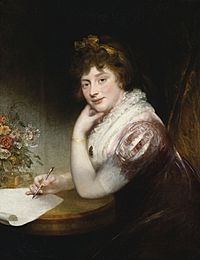Princess Elizabeth of the United Kingdom facts for kids
Quick facts for kids Princess Elizabeth |
|
|---|---|

Portrait by Sir William Beechey, 1797
|
|
| Landgravine consort of Hesse-Homburg | |
| Tenure | 20 January 1820 – 2 April 1829 |
| Born | 22 May 1770 Buckingham House, London, England |
| Died | 10 January 1840 (aged 69) Free City of Frankfurt |
| Burial | 17 January 1840 Mausoleum of the Landgraves, Homburg |
| Spouse |
Frederick VI, Landgrave of Hesse-Homburg
(m. 1818; died 1829) |
| House | Hanover |
| Father | George III, King of the United Kingdom |
| Mother | Charlotte of Mecklenburg-Strelitz |
Princess Elizabeth (born May 22, 1770 – died January 10, 1840) was a princess from the British royal family. She was the seventh child and third daughter of King George III and Queen Charlotte. After she married Frederick VI, the Landgrave of Hesse-Homburg, she moved to Germany. There, she became known as the Landgravine, which is like a princess or duchess of a small German state.
Contents
Early Life of Princess Elizabeth
Princess Elizabeth was born at Buckingham House in London, England, on May 22, 1770. Her father was the King of Great Britain, George III. Her mother was Queen Charlotte.
Elizabeth was christened (given a Christian name) at St. James's Palace on June 17, 1770. Her parents, King George and Queen Charlotte, kept their children, especially the girls, very protected. In 1812, Princess Elizabeth bought her own home called The Priory in Old Windsor, Berkshire.
Interests and Personality
Elizabeth was known for her positive attitude, even though her life was quite strict. She really wanted to get married and have her own family. But she also made sure to enjoy her life by exploring her many interests.
Elizabeth was a very good artist. She made several books of her own drawings and sold them to help charities. She was the only one of King George III's children who liked farming. She even had her own small farm at a rented cottage in Old Windsor. She loved the food from her garden and the eggs, milk, and butter from her animals.
Elizabeth was also known for her great sense of humor. She collected many jokes and funny sayings. She was open and honest, and she didn't like too much formal politeness. She was closest to her sister Augusta and her brother Edward, Duke of Kent. Elizabeth was also the daughter closest to her mother, Queen Charlotte. This made her mother not want her to marry and move away.
Marriage to Frederick VI
In 1814, Princess Elizabeth met Prince Frederick of Hesse-Homburg at a royal ball in Britain. When she saw him in his fancy army uniform, she reportedly said, "If he is single, I will marry him!"
Four years later, Frederick asked for her hand in marriage. Elizabeth was very interested, and her sisters supported her. Even though Frederick was described as overweight and smelled of tobacco, Elizabeth was determined to marry him. Queen Charlotte did not want Elizabeth to move to Germany, but she finally agreed when Elizabeth insisted.
The wedding happened on April 7, 1818, at Buckingham Palace in Westminster. Elizabeth wore a beautiful silver dress. Her brother, the Duke of York, walked her down the aisle. Her father, the King, could not attend because he was very ill.
Their marriage was not just about love, but it was a good arrangement for both of them. Elizabeth was able to leave her strict life in England by moving to Germany. Frederick gained many benefits by marrying into the British royal family. Frederick was surprised to find he was happy with Elizabeth. Elizabeth found her new husband to be smart, kind, and loving. Their marriage lasted until Frederick died in 1829, and it was described as very happy.
Later Life in Germany
On January 20, 1820, Frederick became the Landgrave of Hesse-Homburg after his father passed away. Thanks to Elizabeth's money (her dowry and yearly allowance), he was able to improve the palace in Homburg. Elizabeth was happy to leave behind the strict royal rules she disliked in England. She also built a beautiful Gothic House on the castle grounds.
Elizabeth also started a care center and school in Hanover for children whose mothers worked. Even though she was too old to have children herself, Elizabeth found great joy in working with the children at the school.
She passed away on January 10, 1840, at the age of 69 in Frankfurt am Main, Germany. She was buried in the Mausoleum of the Landgraves in Homburg.
Exhibition
- 2010: Das graphische Werk der Landgräfin Elizabeth 1770–1840 (The Graphic Works of Landgräfin Elizabeth), Museum im Gotischen Haus, Bad Homburg, Germany
Titles and Royal Status
Princess Elizabeth had different titles throughout her life:
- May 22, 1770 – April 7, 1818: Her Royal Highness The Princess Elizabeth
- April 7, 1818 – January 20, 1820: Her Royal Highness The Hereditary Princess of Hesse-Homburg
- January 20, 1820 – April 2, 1829: Her Royal Highness The Landgravine of Hesse-Homburg
- April 2, 1829 – January 10, 1840: Her Royal Highness The Dowager Landgravine of Hesse-Homburg
Images for kids
See also
 In Spanish: Isabel del Reino Unido para niños
In Spanish: Isabel del Reino Unido para niños


